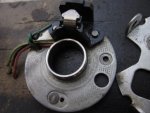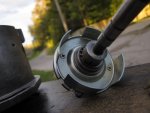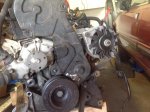The pre-filter draws from below as you suspected. It draws through vanes and can catch a fair amount of fine dust. Doesn't catch much these days since I don't do much dirt road driving anymore.
I think I'd trust a GPS phone for a speed check, even ahead of Jaeger's best effort.
Don't worry about how we RHD people suffer. The 404 was easy to work on. I guess, like the 504, extractors were a bit messy getting around the steering column. We deserve more sympathy because Peugeot never bothered moving the wipers so the driver might get a good look at what he was about to hit. As for the 604, I suspect LHD and RHD suffer equally. At least with all my Pugs I can be grateful I don't have a gearbox and diff shoehorned in there too.
I think you have the insulation of the IAT sensor a bit backwards. The IAT is typically a screw-in brass fitting that will necessarily absorb heat from whatever it screws into. The important thing is that the thermistor and its associated wiring be insulated from its own brass fitting so the thermistor stays at the temperature of the passing air stream, not the metal it's mounted on.
But Jo's comment has got me thinking of going closer to the head too. While on the IAT subject, one thing that is really critical with the Megasquirt setup is injector "dead time". If it's wrong, the temperature compensations can mess things up more than they help. Dead time varies with voltage too -- I recently replaced my alternator and the jump from 13.5V to 14V has seen everything get noticeably richer. All of this is configurable on the MS; getting it all configured correctly is a challenge. Not there yet and I'm toying with a few experiments to accurately gauge my 505's dead time against voltage.
Plenty more hours of torment for you yet.
Have fun,
Rob.
I think I'd trust a GPS phone for a speed check, even ahead of Jaeger's best effort.
Don't worry about how we RHD people suffer. The 404 was easy to work on. I guess, like the 504, extractors were a bit messy getting around the steering column. We deserve more sympathy because Peugeot never bothered moving the wipers so the driver might get a good look at what he was about to hit. As for the 604, I suspect LHD and RHD suffer equally. At least with all my Pugs I can be grateful I don't have a gearbox and diff shoehorned in there too.
I think you have the insulation of the IAT sensor a bit backwards. The IAT is typically a screw-in brass fitting that will necessarily absorb heat from whatever it screws into. The important thing is that the thermistor and its associated wiring be insulated from its own brass fitting so the thermistor stays at the temperature of the passing air stream, not the metal it's mounted on.
But Jo's comment has got me thinking of going closer to the head too. While on the IAT subject, one thing that is really critical with the Megasquirt setup is injector "dead time". If it's wrong, the temperature compensations can mess things up more than they help. Dead time varies with voltage too -- I recently replaced my alternator and the jump from 13.5V to 14V has seen everything get noticeably richer. All of this is configurable on the MS; getting it all configured correctly is a challenge. Not there yet and I'm toying with a few experiments to accurately gauge my 505's dead time against voltage.
Plenty more hours of torment for you yet.
Have fun,
Rob.








